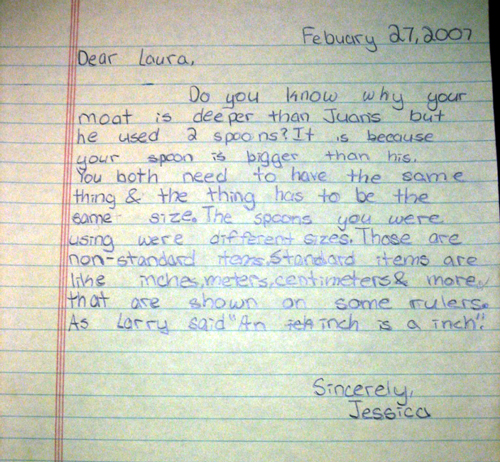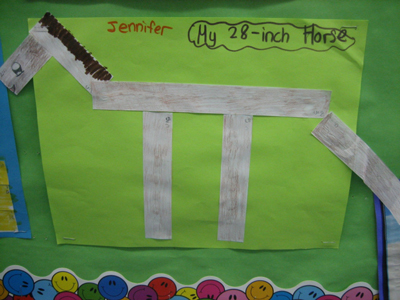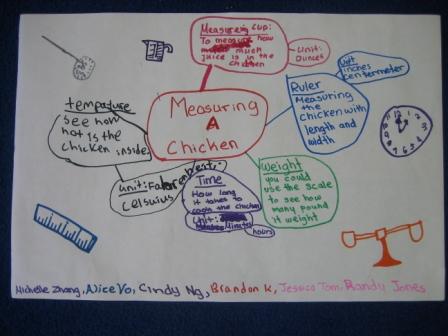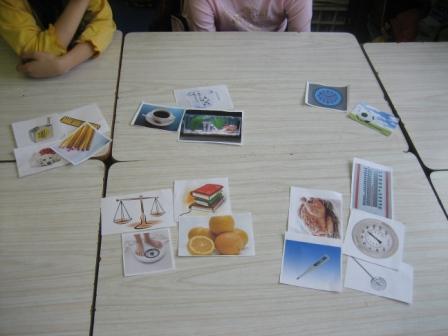Can You Measure Up?
| Name: |
Patricia Kwan |
| School: |
P.S. 124M Yung Wing Elementary School |
| Address: |
40 Division Street |
| City: |
New York, NY, 10002 |
| Original Project: |
Can You Measure Up? |
| Author: |
Carmen Concepcion |
| URL: |
http://teachersnetwork.org/teachnet-lab/miami/2004/concepcion.htm |
How did you modify this unit for use in your own classroom?: While I was preparing my class for the state math test, I tried to look for hands-on, more meaningful and fun ways to review various strands and supplement the lessons that I was already teaching. I used this unit mainly to introduce measurement. I first read Super Sand Castle Sunday by Stuart J. Murphy to begin our discussion of standard versus non-standard measurements. Students then wrote letters to the characters, explaining what their problem was and supplying a suggestion to resolve the problem. For homework, students used various measurement tools (both standard and non-standard) to measure objects found at home. Next, I read Inch by Inch by Leo Lionni. We had an in-depth discussion about why we cannot use an inch to measure the length of a song, but that the inchworm was smart to use it as a way to escape. Students were also able to identify time as a method of measuring a song. After that, students had a lot of fun creating inch art and adding the lengths of the strips they used. Living in a metropolis like New York City with few opportunities to explore wildlife, students inquired whether an inchworm is really one inch long. That inquiry warranted an interesting on-line research and another discussion too!! I had trouble locating a couple of the suggested books at local libraries and bookstores so I supplemented with another book that I found written by an author well-known to the students: How Tall, How Short, How Far Away by David A. Adler. It was the perfect book to segue to larger units of measurement while comparing customary to metric units. After reading, students completed a teacher-created worksheet to review the different units. The following lesson included reading Room for Ripley by Stuart J. Murphy and an exploratory exercise to locate containers in the classroom that held fluids and to identify the units used: water bottles, juice cartons, liquid glue, liquid soap, etc. Students completed a similar activity for homework. I decided to culminate the unit with Measuring Penny by Loreen Leedy because the book reviews all types of measurements that have already been discussed. Since we have read Mapping Penny for our geography unit at the beginning of the year, students were able to make connections between the two books. After reading Measuring Penny, students were divided into groups and given a set of visuals which included measurement tools (thermometers, clock, ruler, scales, measuring tape and measuring cup) and different objects (orange, aquarium, books, pencils, soccer ball, chicken and dog). Groups were first asked to categorize them in any way they wish. We had a discussion about the various categories. Then they tried matching measurement tools to the objects. We discussed variations among the different groups (some groups wanted to measure the weight of the chicken while other groups wanted to measure the temperature of the chicken to see it is cooked). Then groups divided the visuals into two categories – measurement tools and things that they can measure. We held another discussion about the measurement tools – their names and what they measure. Initially, some groups thought that one of the thermometers (circular one) is a scale. Some students also did not know what a measuring tape can measure that a regular ruler cannot. This review was a great exposure for some of the students. Finally, groups chose one object and created a web to show various ways that it can be measured (just like Penny in the story).
List your primary instructional objectives for your students.
| |
Students will be able to identify and measure using standard and non-standard units. |
| |
Students will be able to select appropriate tools and units for the attribute being measured. |
| |
Students will be able to compare different tools and units of measurement. |
| |
|
What role did technology play in this curriculum unit?: The on-line math dictionary and glossary provided great visuals to explain math vocabulary. Students used the websites to create their own dictionary of unfamiliar math terms. Students also enjoyed practicing measurement on funbrain.com. In addition, students used the Internet as a source for research. Some of the URLs were no longer available and therefore could not be used. URLs my students used included: http://teachers.ash.org.au/jeather/maths/dictionary.html http://hbschool.com/glossary/math_advantage/glossary2.html http://funbrain.com/measure/
How did you assess and evaluate student performance?: Students were assessed through teacher observations, oral responses, group discussions and written assignments. Students were assessed in areas of mathematical understanding, participation (whole-class, group and individual), and oral and written expressions.
Please tell us briefly about your background & teaching experience: Ms. Kwan has completed the master’s program in elementary education at Hunter College and has been teaching third grade at P.S. 124M for 6 ½ years. Since graduation, she has taken many other courses and participated in workshops to enrich her academic and pedagogic skills. She has also facilitated teacher workshops in areas of social studies and science, including Teacher’s Network Annual Conferences. Currently, she is taking courses to fulfill requirements for ESL certification. This is the third TeachNet unit that Ms. Kwan have adapted in my classroom.
What are your recommendations for other teachers interested in adapting this unit?: This was a well written math unit with engaging extension activities. The hands-on activities are wonderful supports to the literature, especially for the ELL (English Language Learners) population in my class. On the other hand, students who were normally less engaged during math lessons found the stories to be a lot of fun and were able to make better connections with the mathematical concepts. I have chosen to rearrange the sequence of the read-aloud books to scaffold student learning, which turned out to be highly effective. I have also created additional worksheets to provide students with further practice and to assess whether students understood specific mathematical concepts. Some students were confused with names of the measurement tools and the actual units in which the tools measure. Further investigations and discussions in math vocabulary were needed to clarify any confusion and for students to select appropriate vocabulary to express their thinking.
Teacher-created worksheets
Samples of Student Projects
| |
Student wrote a letter to one of the characters in Super Sand Castle Saturday to explain the problem with their method of measuring and a possible solution to the problem. |
| |
 |
| |
|
| |
Student used strips of paper to create art. He first estimated the length of each strip then measured with a ruler. Finally, he added up the measurements of all the strips to create his title. |
| |
 |
| |
|
| |
Group of students created a web to show various ways they can measure and the units that could be used.,Measure in as Many Ways as You Can! |
| |
 |
| |
|
| |
|
| |
 |
| |
Customary+&+Metric+Units.doc |
| |
Standard and Non-standard Measurement Units |
| |
 |
| |
non+vs+standard+measurement.doc |
| |
|
| |
 |
| |
Liquid+Volume.doc |
|